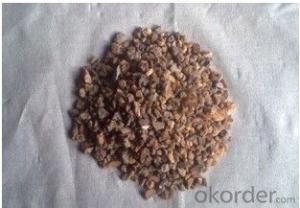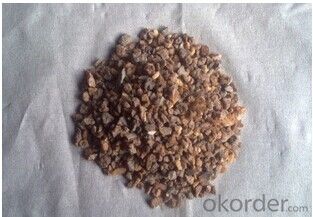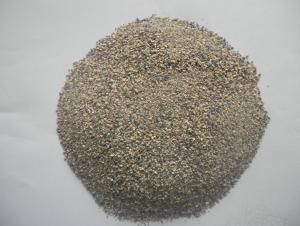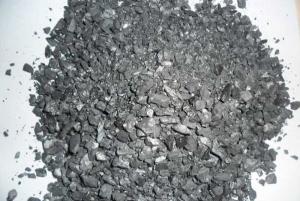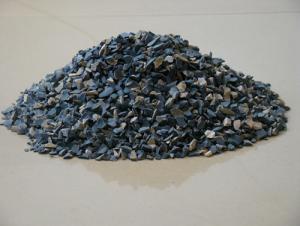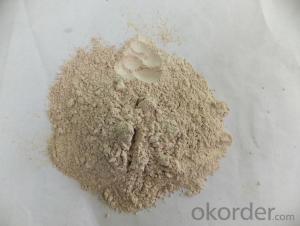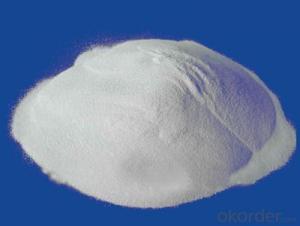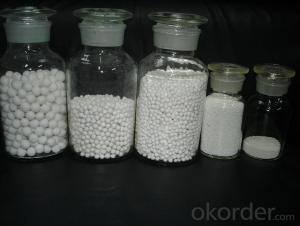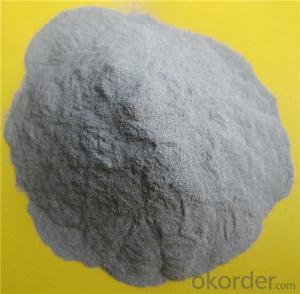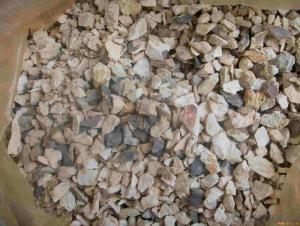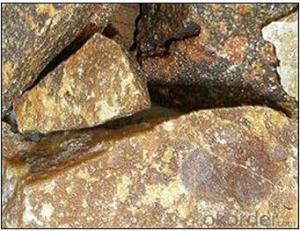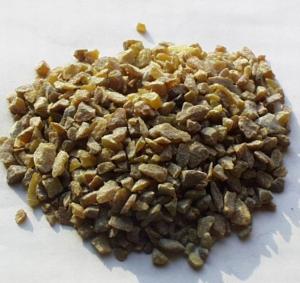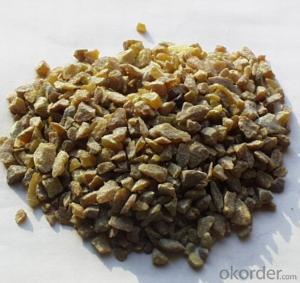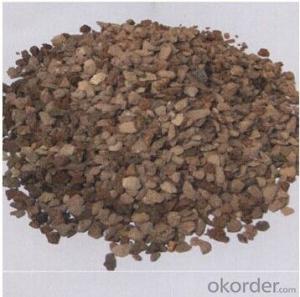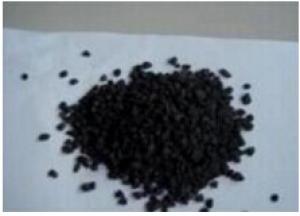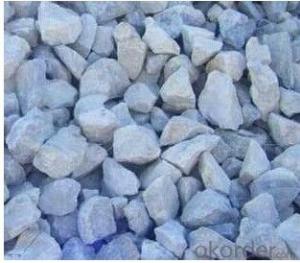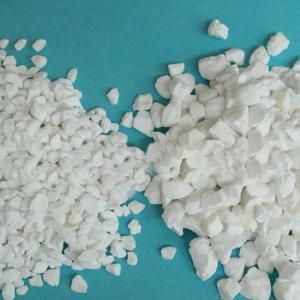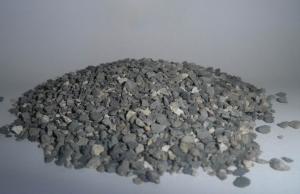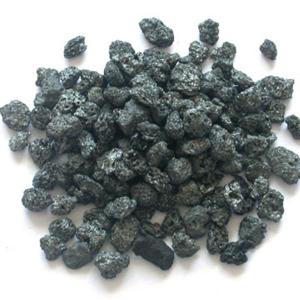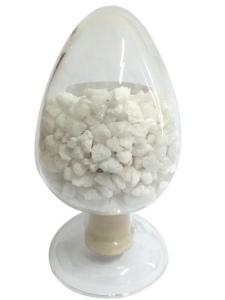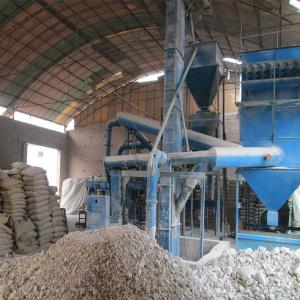Raw Materials for Refractory:Special Electrically Fused Magnesia
- Loading Port:
- China Main Port
- Payment Terms:
- TT OR LC
- Min Order Qty:
- -
- Supply Capability:
- -
OKorder Service Pledge
OKorder Financial Service
You Might Also Like
Fused magnesite sand are manufactured by high purity caustic calcined magnesite through electro-fusing,a part of SiO2,moves to the surface because of the huge difference in the specific which well grown crystals,well crystal perfection and structure homogeneity,excellent chemical stability,good corrosion resistance to slag and high stength at high temperature.it is main raw .material for manufacturing magnesia or magnesiacarbon Bric refractories.The manufactures are mainly used in regenerative chamber in the large scale glass furnace by floating method,electrical furnace,convert furnace,house hold electrical appliances as electrical insulating materials and so on...
Fused Magnesite (Ordinary Grade)
Fused Magnesite (Ordinary Grade) is manufactured through fusing high quality raw magnesite in electric arc furnace with the characteristics of big crystal, dense structure and strong corrosion resistance. As an excellent basic refractory raw material, its MgO content is between 87 – 98%.
Fused Magnesite (Big Crystal)
Fused Magnesite (Big Crystal) is manufactured through fusing high quality calcined magnesite at high temperature in electric arc furnace with the characteristics of complete crystal, dense texture, good high temperature performance and strong corrosion resistance.
Fused Magnesite (Big Crystal) whose MgO content is between 97 – 99% is widely used in refractory industry. Meanwhile, it is also an excellent high-temperature endurable insulating material.
Main products level :
0-1mm;1-3mm; 3-5mm; 0-10mm 50-325 mesh
Electrically fused magnesia has gradually won a place in the special refractories group, owing to its physical superiority over the ordinary grades of dead-burned magnesite. The history of its development dates from the world-war period, when considerable interest was aroused in the sources of supply of magnesite in this country. The economic advantages depend largely on the European situation and the prevailing price for the fused material, but the practical advantages of using a totally shrunk, well-crystallized material are obvious. The crystalline material obtained from various grades of raw material differs somewhat in its physical characteristics, and there is a decided difference in the physical properties between dead-burned magnesite and electrically fused magnesia.
MgO% | 92.0%MIN |
CaO% | 2.0%MAX |
H2O | 0.2%MAX |
SiO2 | 3.0%MAX |
Fe2O3 | 1.0%MAX |
Size | 3-5mm |
- Q: Can anyone tell me what material the first rate fire resistant door is?
- Material of Class A fire doors can be divided into steel and wood, so fire doors can be divided into fireproof steel door and fireproof wooden door. In fact, fire doors of all classes are divided into steel, wood, steel and wood, and other materials (see GB ). Mainly depending on what kind of material the customers want. The fire door is called class A fire door not because of the material but because of the fire-resistant time. The fire resistant time of class A fire door is not less than 1.2 hours and fire doors as long as meeting this condition can be called class A fire doors . The filling material in class A fire doors is generally perlite, whose difference is in thickness. A few of them will use fireproofing materials like foam core board, vermiculite fireproof board, MC composite material and so on. The thickness of class A fire door is usually 50mm. I hope my answer can help you.
- Q: Which manufacturers have the best fire-proof materials with light weight?
- Tinajin SPstar Insulation Material Co.,Ltd. is Chinese agent of German Berkson which is engaged in the application of field of high temperature and thermal insulation for many years and has accumulated experience of application of WDS nanometer scale micropore thermal insulation matrial in a variety of industries. Welcome domestic customers and experts in all industries to contact us and cooperate to promote this new energy-saving insulation materials. Make due contributions for China's energy-saving and sustainable development and low carbon emissions project!
- Q: Fire rating of decoration materials
- You can refer to (code for fire protection design of buildings)
- Q: Who knows what kind of material the fire-proof plate use, and is it good?
- It is the decorative board made by adopting silicious material or calcareous material as the main raw material, and blending them with certain proportion of fibrous material, lightweight?aggregate, adhesive and chemical?additive before steam pressing. It is a kind of new material and more and more frequently used currently not only for it is fireproof. Construction of the fire-proof plate has higher requirements on the adhesive, and the price of the fire-proof plate with better quality is more expensive than that of the decoration panel. The thickness of the fire-proof plate is generally 0.8mm, 1mm, and 1.2mm. So it is the best material for making cupboards.
- Q: How many refractories are there for boiler above 1200 ℃?
- Ordinary clay brick is for burning layer, red brick for external wall, light clay brick for thermal insulation layer, built by clay refractory mortar. Sindeyuan Refractories.Hope you adopt. Thank you. In fact, there are many manufacturers producing furnace burden. We has been using products of Huaheng, which are anti-erosion, easy to construct and can improve production efficiency, reduce steelmaking cost.
- Q: Does anyone know what is the use of waste refractory materials?
- 1.Waste refractory bricks can be reused to make the refractory bricks after being crushed by crusher, but the price is not very high. The purchasing price of refractory plant is ?60/ton. Because the refractory material has been calcinated for two times, it becomes easier to make bricks expansion coefficient with waste refractory bricks, but too much is inadvisable. If too much, the refractory materials would have a bad combination, which will give rise to loose bricks and incomplete corners. Nowadays, ordinary refractory plants would purchase waste refractory bricks to produce bricks, but better plants wouldn’t do this.
- Q: What is the the best matching ratio of refractory cement?
- The ratio of cement and sand is about 30 per cent. Properties and Applications of refractory mortar: 1, Good plasticity and easy construction; 2, High bonding strength and strong corrosion resistance; 3, Relatively high refractoriness up to 1650 ℃ ± 50 ℃; 4, Good slag corrosion resistance; 5, Good thermal peeling. Refractory mortar is mainly used in coke ovens, glass furnaces, hot blast furnace and other industrial furnaces. Applied industry: Metallurgy, building materials, machinery, petrochemicals, glass, boiler, electric power, steel, cement, etc. And refractory cement is also known as aluminate cement. Aluminate cement takes bauxite and limestone as raw materials, alumina content of about 50% as the clinker. And it is a hydraulic cementing material made by grinding. Refractory cement is also known as aluminate cement. Aluminate cement is often yellow or brown or gray. The main mineral of aluminate cement is mono calcium aluminate (CaO · Al2O3, abbreviated CA) and other aluminates, and a small amount of dicalcium silicate (2CaO · SiO2), etc. It is a special cement.
- Q: Firing high temperature kiln of refractory and internal temperature being as high as 1600 ℃, metal heat exchanger can't use, how to do?
- Directly using silicon molybdenum kiln, the temperature is better. Now using the electricity is cheaper than the price of other fuels.
- Q: Who can tell somthing about how to choose fire resistant rating of fire resistance rolling shutter doors?
- There is no necessary connection between them. Different fire resistant ratings of bulidings require different fire endurance of different elemements of buildings. According to the fire endurance, fireproof doors can be divided into A-grade, B-grade and C-grade, whose fire endurance should not be less 1.2h, 0.9h and 0.6h respectively. A-grade fireproof doors can be even applied to the material whose fire resistant rating is at secondary level. "Building Regulations" mention that fire resisting shutter can be used as partition of fire?compartment in those places where setting firewalls is not so easy. When using fire resisting shutter whose fire endurance doesn't include unexposed surface temperature rise, it should install closed independent automatic sprinkler system for protection on both sides, and the sprinkler sholud last at least 3 hours.
- Q: About the use of horseshoe glass kiln refractories
- the lower portion of advanced clay brick, the lower portion of magnesia-chrome brick arch - high-purity silica brick; flue - clay brick; breast wall--33 # fused zirconia corundum brick (with shrinkage); fused zirconia bottom --33 # fused zirconia corundum brick (with shrinkage); regenerative chamber- the upper part of sintered magnesia-chrome brick, cooling section 33 # electric?smelting no shrinkage fused zirconia corundum brick; the wall - the melting section 41 # no shrinkage fused zirconia corundum brick (including 41% of zirconium; the lattice- superstructure of high purity magnesia brick, the same below); small stove --33 # fused zirconia corundum brick (with shrinkage). It can be said that it is the maximum configuration, if the funds is limited it can be downshift appropriately.
Send your message to us
Raw Materials for Refractory:Special Electrically Fused Magnesia
- Loading Port:
- China Main Port
- Payment Terms:
- TT OR LC
- Min Order Qty:
- -
- Supply Capability:
- -
OKorder Service Pledge
OKorder Financial Service
Similar products
Hot products
Hot Searches
Related keywords
